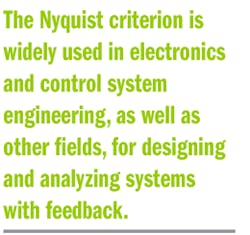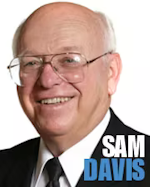As an engineer at Bell Laboratories, Harry Nyquist did important work on thermal noise (“Johnson–Nyquist noise”), the stability of feedback amplifiers, telegraphy, facsimile, television, and other important communications problems. With Herbert E. Ives, he helped to develop AT&T’s first facsimile machines that were made public in 1924. In 1932, he published a classic paper on stability of feedback amplifiers. The Nyquist stability criterion can now be found in all textbooks on feedback control theory.
The Nyquist criterion is widely used in electronics and control system engineering, as well as other fields, for designing and analyzing systems with feedback. While Nyquist is one of the most general stability tests, it is still restricted to linear, time-invariant (LTI) systems. Non-linear systems must use more complex stability criteria, such as Lyapunov or the circle criterion. While Nyquist is a graphical technique, it only provides a limited amount of intuition for why a system is stable or unstable, or how to modify an unstable system to be stable. Techniques like Bode plots, while less general, are sometimes a more useful design tool.
Nyquist’s early theoretical work on determining the bandwidth requirements for transmitting information laid the foundations for later advances by Claude Shannon, which led to the development of information theory. In particular, Nyquist determined that the number of independent pulses that could be put through a telegraph channel per unit time is limited to twice the bandwidth of the channel, and published his results in the papers Certain factors affecting telegraph speed (1924) and Certain topics in Telegraph Transmission Theory (1928). This rule is essentially a dual of what is now known as the Nyquist–Shannon sampling theorem.
Swedish Roots
Nyquist emigrated to the United States in 1907. He entered the University of North Dakota in 1912 and received B.S. and M.S. degrees in electrical engineering in 1914 and 1915, respectively. He received a Ph.D. in physics at Yale University in 1917.
He worked at AT&T’s Department of Development and Research from 1917 to 1934, and continued when it became Bell Telephone Laboratories that year, until his retirement in 1954.
Nyquist received the IRE Medal of Honor in 1960 for “fundamental contributions to a quantitative understanding of thermal noise, data transmission, and negative feedback.” In October 1960, he was awarded the Stuart Ballantine Medal of the Franklin Institute “for his theoretical analyses and practical inventions in the field of communications systems during the past 40 years including, particularly, his original work in the theories of telegraph transmission, thermal noise in electric conductors, and in the history of feedback systems.” In 1969, he was awarded the National Academy of Engineering’s fourth Founder’s Medal “in recognition of his many fundamental contributions to engineering.” In 1975, Nyquist received together with Hendrik Bode the Rufus Oldenburger Medal from the American Society of Mechanical Engineers.
Nyquist lived in Pharr, Texas, after his retirement, and died in Harlingen, Texas, on April 4, 1976.



